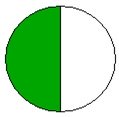Subscribe to our ▶️ YouTube channel 🔴 for the latest videos, updates, and tips.
Comparison of Fractions having the same Numerator
In comparison of fractions having the same numerator the following rectangular figures having the same lengths are divided in different parts to show different denominators.
(i)
Shaded portion = 3/10
(ii)
Shaded portion = 3/5
(iii)
Shaded portion = 3/4
3/10 < 3/5 < 3/4 or 3/4 > 3/5 > 3/10
In the fractions having the same numerator, that fraction is greater which has the smaller denominator.
5/11 > 5/17, 5/17 < 5/11, 7/15 > 7/16, 7/16 < 7/15
Again, comparison of fractions with the same numerator
Take two strips of the same length:
The first strip is divided into 5 equal parts and the second is divided into 7 equal parts. In the first strip, out of 5 equal parts 3 parts are shaded and in the second strip, out of 7 equal parts 3 parts are shaded. Clearly, the shaded part in the first strip is more than that in the second strip.
Thus, 3/5 > 3/7
Hence, among two fractions having the same numerator, the fraction with the smaller denominator is greater than the other.
Solved Examples on Comparison of Fractions having the same Numerator:
1. Compare 6/9, 6/11
Solution:
6/9 and 6/11
Since, 9 < 11
Hence, 6/9 > 6/11
1. Compare 12/17, 12/14
Solution:
12/17 and 12/14
Since, 17 > 14
Hence, 12/17 < 12/14
Comparison Fractions with same Numerator
If two fractions have the same numerator, the fraction with the smaller denominator denotes the greater fraction.
For example,
\(\frac{5}{7}\) > \(\frac{5}{13}\)
\(\frac{9}{15}\) < \(\frac{9}{13}\)
If
there are three or more fractions having the same numerator, they may
be arranged in ascending (increasing) and descending (decreasing) order.
The order will be in opposite order of denominators. The bigger
denominator will make the smaller fraction.
(a) Ascending order: 1/9, 1/7, 1/5, 1/4, 1/3
as 9 > 7 > 5 > 4 > 3
(b) Descending order: 5/3, 5/6, 5/9, 5/12, 5/18
as 3 < 6 < 9 < 12 < 18
Similarly again;
(a) Ascending order: 7/11, 7/9, 7/6, 7/5, 7/2
as 11 > 9 > 6 > 5 > 2
(b) Descending order: 11/1, 11/5, 11/7, 11/10, 11/15
as 1 < 5 < 7 < 10 < 15
Ordering of fraction and comparing fractions:
We know, a fraction represents an equal part of a whole thing.
(a)
A whole cake = 1 cake
We can also write it as 1/1 which means in half the denominator has 1 part and numerator has taken the 1 part.
1/1 = 1.
(b)
Now the cake has been divided into two half parts and one part has been taken.
We write it as 1/2.

\(\frac{1}{3}\) \(\frac{1}{4}\) \(\frac{1}{5}\) \(\frac{1}{6}\)
Note:
As the number of the denominator is getting bigger, the size of the part taken is getting smaller.
1 > 1/2 > 1/3 > 1/4 > 1/5 > 1/6 …..
When the numerator is 1 in a fraction number, it is called a unit fraction.
Related Concept
- Fraction of a Whole Numbers
- Representation of a Fraction
- Equivalent Fractions
- Properties of Equivalent Fractions
- Like and Unlike Fractions
- Comparison of Like Fractions
- Comparison of Fractions having the same Numerator
- Types of Fractions
- Changing Fractions
- Conversion of Fractions into Fractions having Same Denominator
- Conversion of a Fraction into its Smallest and Simplest Form
- Addition of Fractions having the Same Denominator
- Subtraction of Fractions having the Same Denominator
- Addition and Subtraction of Fractions on the Fraction Number Line
From Comparison of Fractions having the same Numerator to HOME PAGE
Didn't find what you were looking for? Or want to know more information about Math Only Math. Use this Google Search to find what you need.



![To convert a percentage into a fraction, place the given number over 100 and reduce it to its lowest term. Consider the following example: (i) 20% [We know % = 1/100]](/image-thumbnails/convert-a-percentage-into-a-fraction.png/default.webp)














New! Comments
Have your say about what you just read! Leave me a comment in the box below. Ask a Question or Answer a Question.